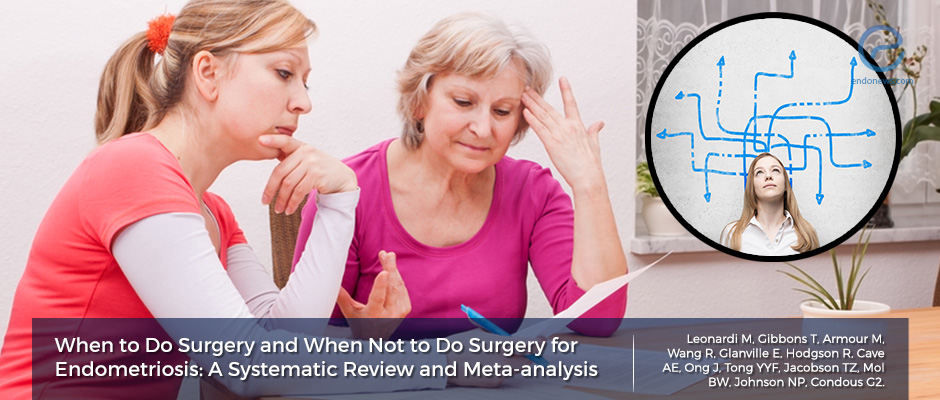When to do - and when not to do surgery for endometriosis
Jan 7, 2020
A systematic review and meta-analysis to answer whether operative laparoscopy is an effective treatment or not
Key Points
Highlight:
- Dr. Leonardi group evaluated the effectiveness of operative laparoscopy on improving symptomatology, recurrence of disease, and pain compared with that of alternative therapies including diagnostic laparoscopy.
Background:
- Endometriosis is estimated to affect about 176 million women worldwide, but unfortunately, the current understanding of this disease is very limited.
- The key question is how to treat patients with the disease.
- Several managements are available such as hormonal contraceptives, progestins, gonadotropin-releasing hormone agonists (GnRH-a) or antagonists and laparoscopic surgery.
- Current therapeutic decision-making is complicated due to the lack of strong evidence showing the effect of operative laparoscopy.
Key points:
- This group evaluated the effectiveness of operative laparoscopy on improving symptomatology, recurrence of disease, and pain compared with that of alternative therapies including diagnostic laparoscopy.
- They reviewed databases that were registered until May 2019 from MEDLINE, Embase, PsycINFO, CINAHL, Web of Science Core Collection, Scopus, and ClinicalTrials.gov.
- Infertility
- Operative laparoscopy probably yields little or no difference in clinical pregnancy rates compared with diagnostic laparoscopy.
- However, the quality of the evidence was very low to answer clearly.
- Disease progression
- There were no eligible randomized controlled trials identified that met inclusion or exclusion criteria for this objective.
- Endometriosis-related pain problems
- Operative laparoscopy was deemed more effective than diagnostic laparoscopy at improving overall pain at 6 months.
- Operative laparoscopy plus GnRH-a is more effective compared with GnRH-a at improving dysmenorrhea at 12 months.
Conclusions:
- Operative laparoscopy seems to improve overall pain levels.
- There is no significant difference in fertility-related or adverse outcomes when compared with diagnostic laparoscopy.
- For better understanding, additional high-quality randomized controlled trials are required.
- Studies on patient preference in surgical decision making and the timing of surgery are also needed.
Lay Summary
Endometriosis is an estrogen-dependent disorder. It was estimated to affect about 176 million women in the world and usually causes pelvic pain and infertility. Unfortunately, the current understanding of this disease is very limited. Though there are many remaining questions, the key question is how to treat patients with the disease.
Several managements are available such as hormonal contraceptives, progestins, and gonadotropin-releasing hormone agonists (GnRH-a) or antagonists. Still, the most frequently used management is laparoscopic surgery. Current therapeutic decision-making is complicated because of many different issues including heterogeneous population, various phenotypes of endometriosis and patient preference (encompassing accessibility to, costs of healthcare, pain, and infertility). However, the main problem is the lack of clear evidence showing the effect of laparoscopic surgery.
Therefore, Dr. Leonardi group from Australia evaluated the effectiveness of operative laparoscopy on improving symptomatology, recurrence of disease, and pain compared with that of alternative therapies including diagnostic laparoscopy. This paper was recently published in the “Journal of minimally invasive gynecology”.
To assess the effectiveness and safety of laparoscopic surgery in the treatment of endometriosis-associated infertility, this group reviewed databases. They searched databases that were registered until May 2019 from MEDLINE, Embase, PsycINFO, CINAHL, Web of Science Core Collection, Scopus, and ClinicalTrials.gov.
Infertility: There was moderate-quality evidence that operative laparoscopy probably yields little or no difference in clinical pregnancy rates compared with diagnostic laparoscopy. The quality of the evidence was very low, it is uncertain if operative laparoscopy improves live birth rates.
Disease progression: There were no eligible randomized controlled trials identified that met inclusion or exclusion criteria for this objective.
Endometriosis-related pain problems: Operative laparoscopy was deemed more effective than diagnostic laparoscopy at improving overall pain at 6 months after surgical intervention. Another study showed that operative laparoscopy plus GnRH-a is more effective compared with GnRH-a at improving dysmenorrhea at 12 months.
In conclusion, operative laparoscopy may improve overall pain levels. However, there is no significant difference in fertility-related or adverse outcomes when compared with diagnostic laparoscopy. For better understanding, additional high-quality randomized controlled trials, including comparing surgery to medical management, are needed. Specifically, detail information such as fertility, disease progression related and adverse events. Lastly, studies on patient preference in surgical decision making and the timing of surgery are needed.
Research Source: https://www.ncbi.nlm.nih.gov/pubmed/31676397
Endometriosis Laparoscopy Pelvic pain Infertility Quality of life Patient preference

